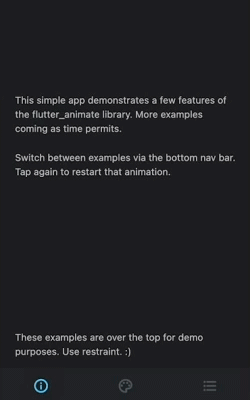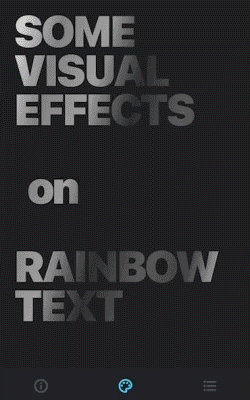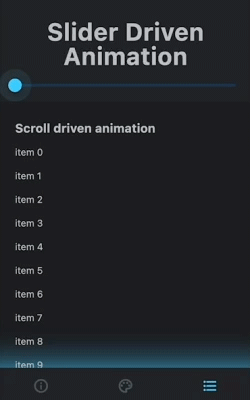A performant library that makes it simple to add almost any kind of animated effect in Flutter.
- Pre-built effects, like fade, scale, slide, blur, shake, shimmer, and color effects (saturation and tint)
- Easy custom effects and simplified animated builders
- Synchronize animations to scroll, notifiers, or anything
- Integrated events
All via a simple, unified API without fussing with AnimationController and StatefulWidget.
NOTE: This library is currently in prerelease. Some aspects of the API will change as it is refined. Your feedback is welcome via Github issues.
Above: The included example app.
This package includes extension methods for num, to make specifying durations
easier. For example: 2.seconds, 0.1.minutes, or 300.ms.
To apply effects, wrap the target widget in Animate, and specify a list of
effects:
Animate(
effects: [FadeEffect(), ScaleEffect()],
child: Text("Hello World!"),
)It also adds an .animate() extension method to all widgets, which wraps the
widget in Animate(). Each effect also adds a chainable extension method to
Animate to enable a shorthand syntax:
Text("Hello World!").animate().fade().scale()NOTE: The shortform style is used in this README, but all functionality is available in either format.
Effects have optional delay, duration, and curve parameters. Effects run
in parallel, but you can use a delay to run them sequentially:
Text("Hello").animate()
.fade(duration: 500.ms)
.scale(delay: 500.ms) // runs after fade.Note that effects are "active" for the duration of the full animation, so for
example, two fade effects on the same target can have unexpected results
(SwapEffect detailed below, can help address this).
If not specified (or null), these values are inherited from the previous effect,
or from Animate.defaultDuration and Animate.defaultCurve if it is the first
effect:
Text("Hello World!").animate()
.fadeIn() // uses `Animate.defaultDuration`
.scale() // inherits duration from fadeIn
.move(delay: 300.ms, duration: 600.ms) // runs after the above w/new duration
.blur(end: 8.0) // inherits the delay & duration from moveAnimate also has its own delay parameter, which happens before the animation
runs. Unlike the delay on an Effect, it is only applied once if the animation
repeats.
Text("Hello").animate(
delay: 1000.ms, // this delay only happens once at the very start
onPlay: (controller) => controller.repeat(), // loop
).fadeIn(delay: 500.ms) // this delay happens at the start of each loopThenEffect is a special "convenience" effect that simply sets its own
inheritable delay to the sum of the delay and duration of the previous effect,
and its own (optional) delay. This makes it easier to sequence effects.
In the following example, the slide would run immediately after the fade ended, then the blur would run 200ms after the slide ended.
Text("Hello").animate()
.fadeIn(delay: 300.ms, duration: 500.ms)
.then() // sets own delay to 800ms (300+500)
.slide(duration: 400.ms) // inherits the 800ms delay
.then(delay: 200.ms) // sets delay to 1400ms (800+400+200)
.blur() // inherits the 1400ms delay
// Explicitly setting delay overrides the inherited value.
// This move effect will run BEFORE the initial fade:
.move(delay: 0.ms)The AnimateList class offers similar functionality for lists of widgets, with
the option to offset each child's animation by a specified interval:
Column(children: AnimateList(
interval: 400.ms,
effects: [FadeEffect(duration: 300.ms)],
children: [Text("Hello"), Text("World"), Text("Goodbye")],
))
// or shorthand:
Column(
children: [Text("Hello"), Text("World"), Text("Goodbye")]
.animate(interval: 400.ms).fade(duration: 300.ms),
)Because Effect instances are immutable, they can be reused. This makes it easy
to create a global collection of effects that are used throughout your app and
updated in one place. This is also useful for design systems.
MyGlobalEffects.transitionIn = <Effect>[
FadeEffect(duration: 100.ms, curve: Curves.easeOut),
ScaleEffect(begin: 0.8, curve: Curves.easeIn)
]
// then:
Text('Hello').animate(effects: MyGlobalEffects.transitionIn)It is easy to write new resuable effects by extending Effect, but you can also
easily create one-off custom effects by using CustomEffect, ToggleEffect,
and SwapEffect.
CustomEffect lets you build custom animated effects. Simply specify a
builder function that accepts a context, value, and child. The child is
the target of the animation (which may already have been wrapped in other
effects).
For example, this would add a background behind the text and fade it from red to blue:
Text("Hello World").animate().custom(
duration: 300.ms,
builder: (context, value, child) => Container(
color: Color.lerp(Colors.red, Colors.blue, value),
padding: EdgeInsets.all(8),
child: child, // child is the Text widget being animated
)
)By default it provides a value from 0-1 (though some curves can generate
values outside this range), based on the current time, duration, and curve. You
can also specify begin and end values as demonstrated in the example below.
Animate can be created without a child, so you use CustomEffect as a
simplified builder. For example, this would build text counting down from 10,
and fading out:
Animate().custom(
duration: 10.seconds,
begin: 10,
end: 0,
builder: (_, value, __) => Text(value.round()),
).fadeOut()ToggleEffect also provides builder functionality, but instead of a double,
it provides a boolean value equal to true before the end of the effect and
false after (ie. after its duration).
Animate().toggle(
duration: 2.seconds,
builder: (_, value, __) => Text(value ? "Before" : "After"),
)This can also be used to activate "Animated" widgets, like AnimatedContainer,
by toggling their values with a minimal delay:
Animate().toggle(
duration: 1.ms,
builder: (_, value, __) => AnimatedContainer(
duration: 1.second,
color: value ? Colors.red : Colors.green,
),
)SwapEffect lets you swap out the whole target widget at a specified time:
Text("Before").animate()
.swap(duration: 900.ms, builder: (_, __) => Text("After"))This can also be useful for creating sequential effects, by swapping the target widget back in, effectively wiping all previous effects:
text.animate().fadeOut(300.ms) // fade out & then...
// swap in original widget & fade back in via a new Animate:
.swap(builder: (_, child) => child.animate().fadeIn())Animate includes the following callbacks:
onPlay: the animation has started playing after anyAnimate.delayonComplete: the animation has finished
These callbacks return the AnimationController, which can be used to
manipulate the animation (ex. repeat, reverse, etc).
Text("Horrible Pulsing Text")
.animate(onPlay: (controller) => controller.repeat(reverse: true))
.fadeOut(curve: Curves.easeInOut)For more nuanced callbacks, use CallbackEffect or ListenEffect.
CallbackEffect lets you add a callback to an arbitrary postion in your
animations. For example, adding a callback halfway through a fade:
Text("Hello").animate().fadeIn(duration: 600.ms)
.callback(duration: 300.ms, callback: (_) => print('halfway'))As with other effects, it will inherit the delay and duration of prior effects:
Text("Hello").animate().scale(delay: 200.ms, duration: 400.ms)
.callback(callback: (_) => print('scale is done'))ListenEffect lets you register a callback to receive the animation value (as a
double) for a given delay, duration, curve, begin, and end.
Text("Hello").animate().fadeIn(curve: Curves.easeOutExpo)
.listen(callback: (value) => print('current opacity: $value'))The above example works, because the listen effect inherits duration and curve
from the fade, and both use begin=0, end=1 by default.
By default, all animations are driven by an internal AnimationController, and
update based on elapsed time. For more control, you can specify your own
external controller, or use an adapter.
Adapters synchronize the AnimationController to an external source. For
example, the ScrollAdapter updates an animation based on a ScrollController
so you can run complex animations based on scroll interactions.
You still define animations using durations, but the external source must
provide a 0-1 value.
Flutter Animate ships with a collection of useful adapters. Check them out for more information.
Grab it from pub.dev.


